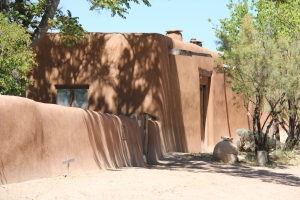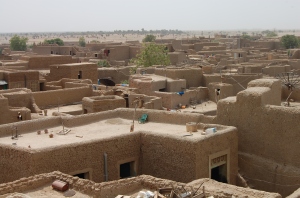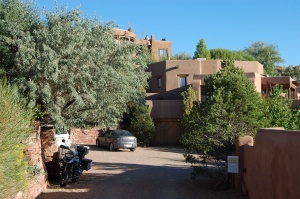New Mexico.
What an amazing array of people and cultures there are here, and not always happily sharing the land – there is a bloody history of conquest, domination and revolt. A relatively young state, which uses the slogan, ‘Land of Enchantment’, must be extremely ironic to those who are clearly disenchanted. Todays New Mexico is a mixture of Indigenous Americans, Hispanics and Anglos, who arrived here in that order. I have been both meeting people and looking at architecture from those three cultures. Hispanic villages in the mountains, Indian villages – or Pueblos, both ancient and modern, and the recent, highly fashionable (and very expensive) adobe architecture of Santa Fe. I have hardly seen a common kiln fired house brick for weeks.
Santa Fe city does not allow any new building to be made in materials other than adobe, and they have to be no more that two stories high. This means that the views across town, are completely remarkable compared to most other towns or cities in the US – there are no high rise buildings here at all. This delightful city is human scale, the centre is walkable (very unusual again), the building materials are locally sourced and soft warm terracotta earth walls are everywhere.
I’ve been staying in a very beautiful adobe house owned by Emaho Montoya, a truly generous man of Tewa Indian and Hispanic descent. Based on the traditional circular shape of the Kiva, this house has open spaces and rooms leading from a circular mezzanine above an open circular well below, which similarly leads to a network of surrounding rooms. The massive pine tree trunk beams that support the ceiling create a solid feel and sturdy structure. The mud walls are very thick and substantial, creating cool interiors even when the sun blazes outside.
Heading north from Santa Fe, on route 285/84, you are quickly within the Indian Reservations and Pueblos. Here imposing Casino after Casino erupts from beside the road. These have been build by the Indian Councils to attract money into the Reservations, where there is generally evidence of widespread poverty. Not everyone is poor here, there are exceptions, when for instance someone has a steady job, perhaps at Los Alamos Research Lab, a short distance away. During my visit to one of the countries top native american sculptors, Nora Noranjo Morse, in Santa Clara Pueblo, she talked about the problems facing her people. The lack of opportunity, the lack of money, the lack of connection with the old ways for the majority of the population. Nora is working hard to re instill a sense of connection to the earth by working with young people on creative gardening projects within her community. The practical side to this is also young people are learning to grow their own food, learning which herbs are medicinal and have been used for centuries here. It would be wrong of me to ignore the sense of injustice that these Indigenous Americans must feel when comparing their lifestyles to those of the Anglo’s generally. Nora is a busy woman, she makes clay sculptures and maquettes of larger cast pieces. She has been working hard on a film which has developed from a commission she won, to make sculptures outside the National Museum of the American Indian, in Washington. The sculptures she designed used natural materials and building methods – a project in which she collaborated with Bill and Athena Steen (her niece). http://www.nmai.si.edu/alwaysbecoming/AlwaysBecoming.html
The Hispanic villages that i have visited have included Chimayo, to see the adobe church where the earth is sacred – no literally. Built on a native amercan site where the soils were reputed to have healing properties, people come form all over the USA to rub themselves with the sacred soil and they sometimes feel better. Rather liek at Lourdes, in France. Visitors can take away a handful if they scoop it from a pit themselves. I did. I plan to incorporate it into a piece of art in the future.
So to another hispanic settlement, Abiqui, which contains one of the homes of Georgia O’Keefe. Off route 84, this village is being carefully kept away from too many tourists, by the O’Keefe Foundation. We were encouraged to rendezvous at the roadside Abiqui Inn, two miles from the village and were shuttled in for a whistle-stop tour. At $30 per tour, it allows a very limited view of the house and studio, this must also keep people away. It must also make us wonder whether it was worth the $30!
The house itself was a solid old Spanish villa, set in several acres of land, still gardened by the same family who worked for O’Keefe. The house had been restored sympathetically by O’Keefe, with her friend overseeing the work. As we were not allowed to take any photos of the house what so ever, so i cannot show you much of it. I went back to the village after the tour had ended, to get a feel of the village and take photos of it.
 Georgia O’Keefe’s Abiqiui residence from the village gate.
Georgia O’Keefe’s Abiqiui residence from the village gate.
What really strikes me looking at this architecture, is the similarity to that of West African buildings. There is a solidity and grandeur. A relationship with the land on which it sits, almost as if it has grown organically from the soil.
Djénné in Mali and Santa Fe, New Mexico – which is which?


